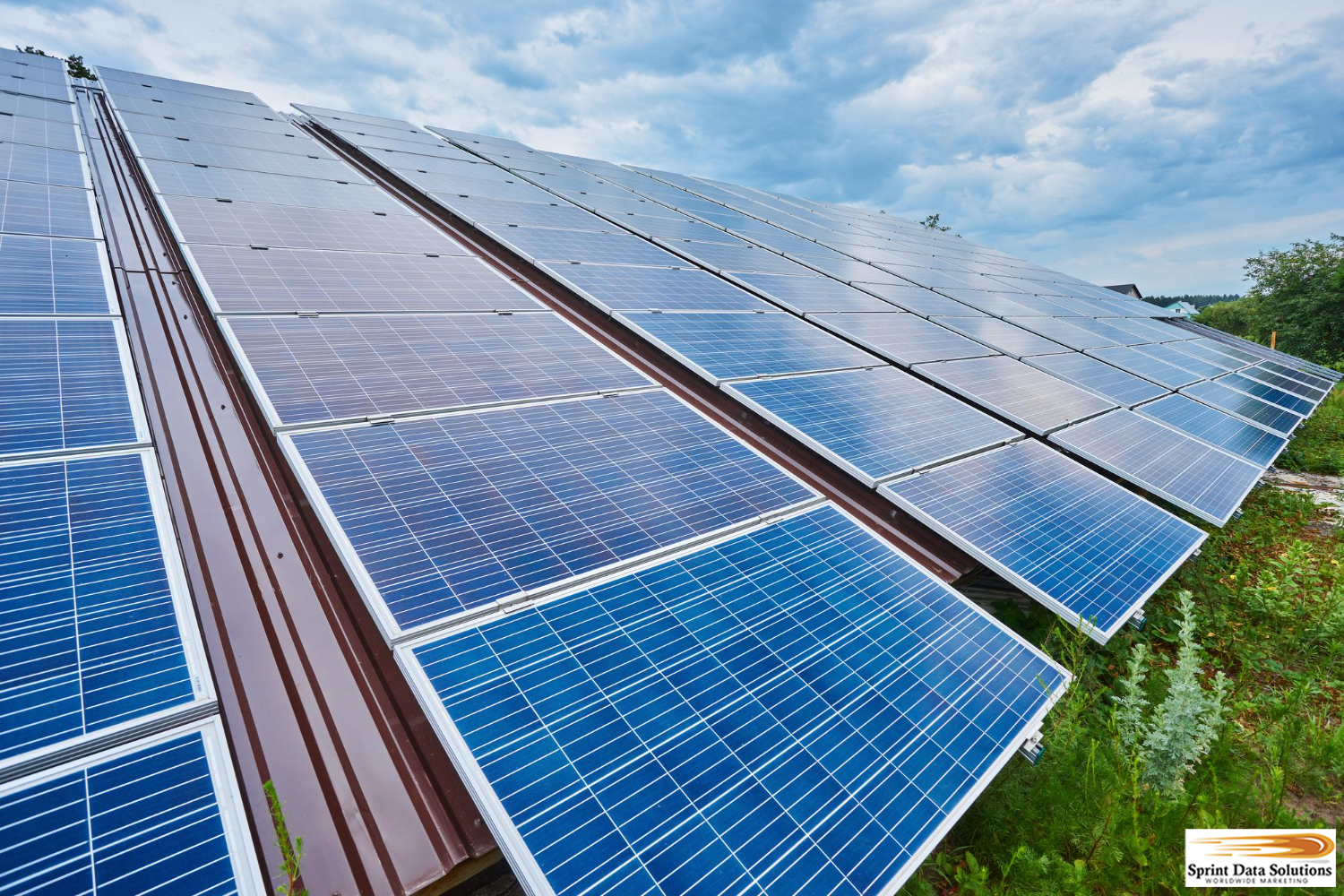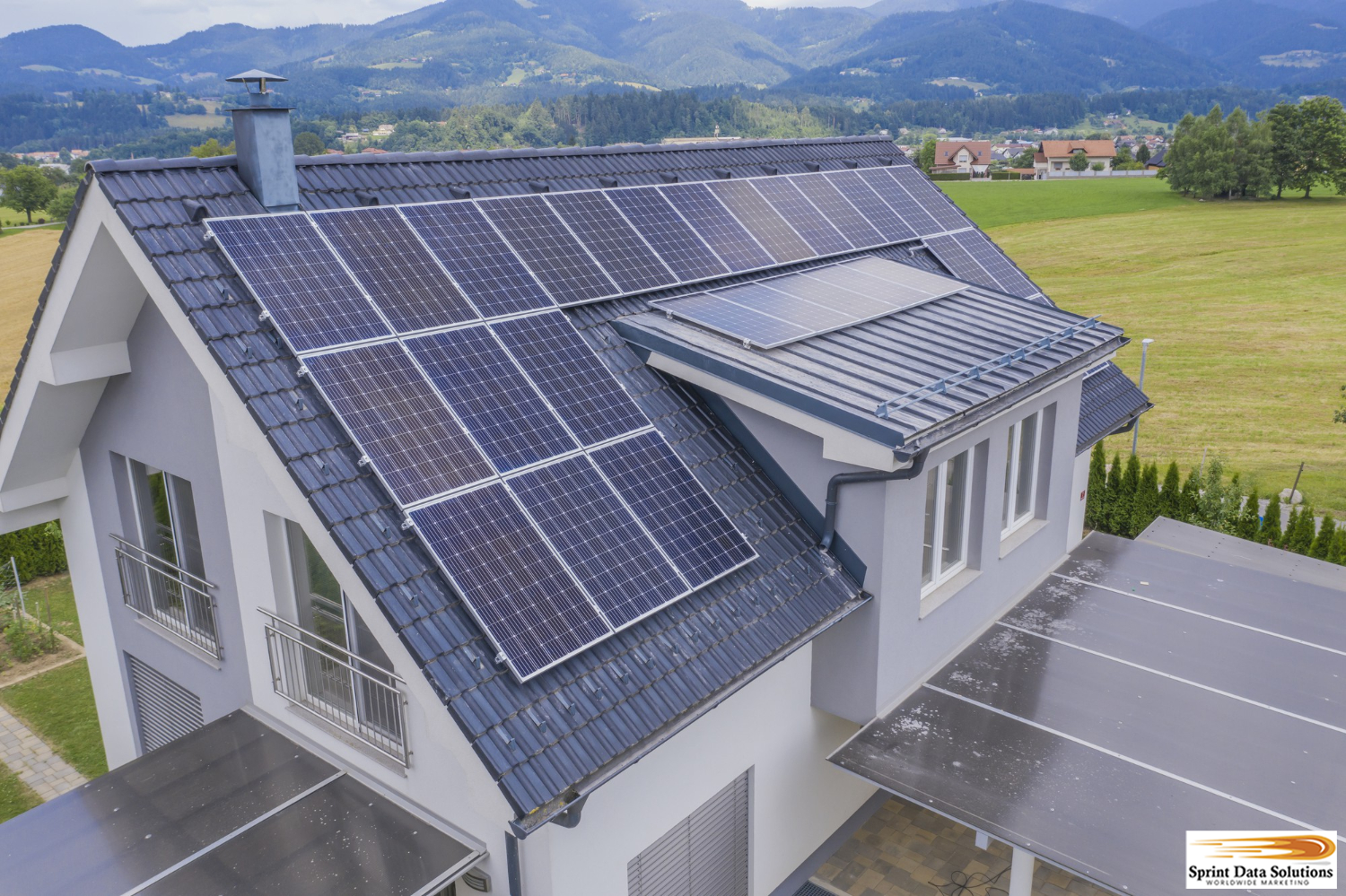Solar Power Is Generating More Leads Than Ever Before
Energy is the backbone of modern society, particularly in the United States, where electricity powers nearly every aspect of daily life. From providing light in homes and enabling communication through phones to powering transportation and manufacturing processes, electricity has become indispensable. It is so fundamental that it is categorized as a utility, not a luxury. Without it, contemporary society would collapse, as businesses, homes, and even hospitals would be unable to function. Hospitals, especially, rely heavily on electricity to operate life-saving medical equipment, monitor patients, and support critical services. This makes electricity not just a convenience, but a matter of life and death in many instances.
The evolution of energy generation in the U.S. reflects both technological advancements and a growing awareness of environmental concerns. Initially, the country’s energy needs were met primarily through coal-fired power plants, a practice that has been criticized for its environmental impact due to greenhouse gas emissions. In addition to coal, the United States also harnessed the power of water through hydroelectric dams, using flowing rivers to turn turbines and generate electricity. The introduction of nuclear energy in the mid-20th century represented another leap forward, providing large-scale electricity generation with minimal direct carbon emissions, though concerns about safety and waste management persist.
Today, the landscape of energy generation in the U.S. is incredibly diverse, offering a range of options that aim to balance the need for power with environmental considerations. The shift towards cleaner and more sustainable energy sources has been driven by advancements in technology and growing demand for renewable energy. Solar power has seen exponential growth due to declining costs and technological improvements in efficiency. Wind energy, once limited to a few locations with ideal conditions, has now become a major player in the U.S. energy mix, with wind farms dotting the landscape across the country.
Furthermore, innovations in energy storage technologies and the increasing adoption of electric vehicles are transforming the way we think about power generation and consumption. Wind and solar power, which are intermittent by nature, can now be stored in large batteries, providing a more reliable and stable supply of energy even when the sun isn’t shining or the wind isn’t blowing. These advancements are paving the way for a more resilient and sustainable energy future. Meanwhile, research into nuclear fusion continues, promising an even cleaner, more efficient form of energy generation that could revolutionize the sector in the coming decades.
In short, the diversity of energy sources now available ensures that America has the flexibility to meet its energy demands while addressing the pressing need for environmental responsibility. The ongoing evolution of the energy sector reflects the nation’s determination to balance progress with sustainability, securing a reliable power supply for generations to come.

Coming Into Its Own
Solar power, as both a concept and a technology, has evolved significantly over the past few decades. While the basic principles of harnessing sunlight to generate electricity date back to the 19th century, it wasn’t until the 1950s that the first practical photovoltaic (PV) cells were developed. These early solar cells, made from silicon, were highly inefficient, converting less than 6% of the sunlight they received into usable electricity. Despite their limited efficiency, they were an important step forward, and by the 1980s, solar technology had made its way into more widespread applications, such as providing power for calculators and other small devices. However, generating significant amounts of electricity for larger applications remained a challenge.
The early solar farms that aimed to generate larger quantities of electricity were massive undertakings. These projects required vast fields of solar panels, often spread over hundreds of acres of land in flat, sunny areas like California’s deserts. These early solar farms not only needed an enormous amount of land to accommodate large solar arrays but also relied on innovative and expensive methods such as motorized mirrors and heliostats, which concentrated sunlight onto the solar panels to improve efficiency. Despite these advances, the process of producing electricity from solar energy at scale was still a highly complex and expensive venture.
Fast forward to the present day, and the landscape of solar energy has changed dramatically. Advances in solar cell technology, particularly with the development of more efficient and durable photovoltaic materials like monocrystalline and polycrystalline silicon, have made solar power far more accessible and affordable. Today’s solar panels are significantly more efficient than their predecessors, with some high-end models converting over 22% of sunlight into usable energy. This means that much smaller arrays are now capable of producing the same amount of energy that required vast solar fields in the past.
In addition, the integration of solar power into everyday life has become increasingly common. Residential solar systems, once seen as a luxury, are now within reach of many homeowners. A typical solar panel system installed on the roof of an average-sized home can generate enough electricity to power the entire home, and in many cases, homeowners can generate excess energy. This surplus energy can be fed back into the grid, allowing property owners to receive compensation or credits through net metering arrangements, sometimes even generating income. As more communities adopt solar power, solar energy has become a key component of sustainable energy systems, contributing to a cleaner, more resilient grid.
The ongoing advancements in solar technology, coupled with falling installation costs, have propelled solar energy from an experimental technology to a mainstream energy solution. As the world continues to face growing concerns about climate change and the environmental impacts of traditional energy sources, solar power stands out as one of the most promising and scalable solutions to meet the increasing global demand for clean, renewable energy. As technology continues to improve, solar energy is expected to play an even larger role in the global energy mix, with the potential to power entire cities and regions from abundant natural sunlight.
As a means of generating “free” electricity once installed, solar power has come a long way, and there is more interest in it for several reasons.
A Stable Alternative
One of the most compelling advantages of solar power over other forms of electrical generation is its inherent stability, both in terms of energy production and economic reliability. Unlike some renewable systems, such as wind power, which can face unpredictable energy output due to variations in wind strength, solar panels offer a more consistent performance. Even on cloudy or rainy days, solar panels continue to generate power, although at a reduced efficiency compared to bright, sunny conditions. This ability to produce energy even in less-than-ideal weather conditions makes solar power a more dependable option for households and businesses seeking continuous electricity supply.
The economic stability provided by solar power is another significant benefit. With solar energy systems in place, property owners can drastically reduce their dependence on electricity sourced from traditional power grids. In some cases, solar panels allow properties to generate more energy than they consume, enabling them to feed surplus electricity back into the grid, often earning credits or payments from utility companies. This level of self-sufficiency provides financial predictability and shields property owners from the volatile pricing of fossil fuels like oil, coal, or natural gas, whose prices can fluctuate unpredictably due to geopolitical tensions, global supply shortages, tariffs, or price manipulations by major corporations. As a result, businesses and homeowners who invest in solar power can avoid the often steep price hikes caused by these external forces, ensuring a more stable and affordable long-term energy solution.
Perhaps one of the most valuable aspects of solar power is the level of independence it offers. In the event of a power outage, homes or businesses equipped with solar panels, especially those with energy storage systems like batteries, can continue to operate unaffected by disruptions in the local grid. This independence can be critical during extended blackouts, ensuring that essential operations—such as refrigeration, heating or cooling, and communication systems—remain functional. Unlike backup generators that require fuel, which can run out or be difficult to obtain during widespread outages, solar energy systems offer a renewable, self-sustaining power source. This level of autonomy is particularly beneficial in areas prone to frequent power disruptions or natural disasters, giving property owners peace of mind knowing that they can rely on a steady flow of energy regardless of external circumstances.
In summary, solar energy provides a triple layer of reliability: consistent energy generation, economic stability, and independence during power outages. These factors make solar power an increasingly attractive choice for those seeking to minimize reliance on the grid, reduce energy costs, and secure a sustainable future. As technology continues to advance and solar power becomes even more efficient and affordable, the widespread adoption of solar energy systems will only become more appealing, offering long-term benefits for both individuals and businesses.
It’s Not Just Homes
Solar panels have become a popular choice for many private residences, offering an eco-friendly and sustainable way to generate electricity. However, it’s not just homes that stand to benefit from this upgrade. Businesses, too, can experience substantial advantages from adopting solar power. Installing solar panels can significantly reduce energy costs, providing businesses with a more reliable and independent energy source. While the initial investment can be substantial, the long-term financial benefits are undeniable. Over time, businesses can experience lower electricity bills, tax incentives, and even the potential to sell excess power back to the grid. Additionally, businesses that switch to solar power can enhance their sustainability credentials, appealing to environmentally-conscious customers and partners. This upgrade can lead to a more resilient energy infrastructure, insulating businesses from rising energy prices and fluctuating utility rates. Overall, the move towards solar energy offers a strategic, cost-effective solution for businesses aiming to reduce operating expenses and align with the growing demand for green energy. Some of the companies that can see a boost from solar power are:
Manufacturing
Manufacturing businesses, particularly those with expansive facilities, are exceptionally well-suited for the integration of solar power due to two key factors: ample roof space and high electricity consumption. Large manufacturing plants often have extensive rooftops, offering ideal spaces to install numerous solar panels. These roofs are typically underutilized and provide the perfect real estate for such energy solutions. Additionally, manufacturing operations are energy-intensive, requiring significant amounts of power for machinery, lighting, and climate control, among other needs. This combination of factors makes the sector a prime candidate for solar energy adoption.
While the initial investment in solar panel installation may seem substantial, the long-term benefits far outweigh the costs. The electricity generated by solar panels allows manufacturing facilities to reduce their dependence on the grid, leading to immediate and considerable savings. The return on investment (ROI) can be realized quickly, as the energy costs associated with running a large-scale operation drop significantly. Over time, this reduction in energy expenditure helps stabilize operational costs, providing manufacturers with greater financial predictability and efficiency. Additionally, as energy prices continue to rise, businesses that have adopted solar energy are positioned to maintain more stable, cost-effective operations, contributing positively to their bottom line and long-term financial sustainability. Solar energy also enhances a company’s green credentials, providing a sustainable solution that can be used for marketing and positioning within environmentally-conscious industries.
Livestock
Farming and agriculture continue to play a vital role in America’s economy and daily life, with livestock operations often requiring careful attention to environmental conditions. In particular, livestock that are housed in temperature-controlled environments, such as chickens, require consistent heating during the colder months to maintain optimal health and productivity. This heating demand can translate into significant energy costs, putting pressure on farmers and ranchers. However, as with many industries, adopting solar power systems can offer a cost-effective and sustainable solution to offset these rising expenses.
In large-scale livestock operations, especially those with expansive indoor facilities, there is often a vast, unused roof area that presents an excellent opportunity for solar panel installation. These roofs, which are typically underutilized, can be transformed into valuable energy sources by installing solar panels that generate electricity to power heating systems. This can be particularly beneficial in facilities that need to maintain a steady temperature for eggs or other sensitive products. By harnessing the power of the sun, farmers can drastically reduce their reliance on traditional energy sources, lowering their heating costs and improving their financial stability.
The initial investment in solar panel installation may seem significant, but the long-term savings can quickly justify the expenditure. With the energy generated from the panels, farmers can offset the costs of heating, as well as other electrical needs, such as lighting and ventilation, leading to lower utility bills overall. Over time, these savings can pay for the installation costs, delivering a strong return on investment. Furthermore, installing solar power systems aligns with sustainable farming practices, reducing the environmental impact of energy consumption and enhancing the farm’s reputation for eco-friendly operations. For those looking to improve profitability while embracing green energy, solar power is an increasingly attractive option for livestock operations of all sizes.
Commercial
It’s not only industrial businesses that can realize significant benefits from transitioning to solar power. Many other sectors, particularly in the white-collar industry like technology, finance, and professional services, stand to gain substantially from adopting solar energy solutions. Office buildings, for instance, consume a substantial amount of electricity to support daily operations. While the energy demands of office equipment, such as computers, printers, photocopiers, and telephones, may not be as high as those in manufacturing environments, they create a consistent and steady draw on the electrical grid throughout the workday.
By installing solar panels on office rooftops or across the business premises, companies can significantly reduce their reliance on external energy sources and lower their electricity bills. In fact, businesses with a substantial energy consumption could potentially achieve energy independence by relying entirely on solar-generated power, moving away from the grid altogether. This can not only result in significant cost savings over time but also improve sustainability efforts and reduce the business’s carbon footprint. Furthermore, solar energy systems offer a long-term solution with minimal maintenance, making it an appealing option for businesses looking to cut down on operational costs while supporting environmental initiatives.
For larger office buildings, incorporating solar panels can even allow companies to generate excess power, which could be sold back to the grid, creating an additional revenue stream or offsetting the initial installation costs. With advancements in energy storage technologies, businesses can store excess energy generated during the day for use at night or during peak demand periods, ensuring uninterrupted operations. This shift towards clean, renewable energy not only boosts a company’s bottom line but also aligns with growing consumer and investor preferences for eco-conscious business practices.
Retail
Retail businesses, particularly those operating large-scale properties like shopping malls or big-box retailers, consume substantial amounts of electricity. This energy is essential not only for keeping the lights on but also for powering various systems such as security cameras, alarm systems, and climate control. Larger retail establishments with their own buildings have an opportunity to reduce their energy costs significantly, especially by utilizing the extensive roof areas that often go underutilized aside from their basic structural function.
One of the most effective strategies for these businesses is installing solar panels on the rooftops or other unused sections of the property. Solar power is an increasingly popular option because it allows businesses to tap into renewable energy sources. The benefits of this approach are twofold: it can drastically offset electricity consumption and lead to substantial savings on utility bills. Solar energy is reliable and predictable, which makes it an attractive option for businesses seeking a fixed energy cost. Unlike fluctuating energy prices from traditional utility companies, solar power provides stability in budgeting, allowing businesses to forecast their energy expenses with greater accuracy.
Furthermore, when solar panels are installed on a large scale, they can produce enough energy to either drastically reduce a company’s reliance on external power suppliers or even achieve full energy independence. This not only cuts down on operational expenses but can also lead to potential revenue generation through the sale of excess energy back to the grid. Achieving such a level of energy autonomy can be transformative, turning a significant operating cost into a source of profit. Over time, the initial investment in solar technology is often offset by the reduction in electricity expenses, resulting in a long-term positive impact on the company’s bottom line.
The implementation of solar energy solutions also adds a layer of sustainability to a company’s operations. As businesses and consumers alike become increasingly aware of the environmental impact of energy consumption, adopting renewable energy options can enhance the company’s image, aligning with the growing demand for eco-conscious practices. Additionally, many governments offer incentives, rebates, or tax credits for businesses that invest in renewable energy infrastructure, further lowering the cost of installation and improving the financial outlook for these businesses.
Overall, the integration of solar panels into the infrastructure of large retail properties presents an incredible opportunity. Beyond just cost savings, it offers a chance for businesses to be more energy-efficient, environmentally responsible, and financially robust in the long term. By eliminating or significantly reducing electricity expenses, companies can boost profitability while contributing positively to the global movement toward sustainable energy.

Residential
Solar power generation has made a profound impact on the private residential sector, offering homeowners a powerful way to regain control over their energy consumption and costs. One of the most significant challenges homeowners face is the unpredictability of monthly electricity bills. In many regions, utility rates can fluctuate drastically depending on factors such as geographical location, local infrastructure, and the pricing structure set by energy providers. Additionally, some areas implement dynamic pricing, where costs rise during peak demand hours and decrease during off-peak times. This creates uncertainty for homeowners who are left trying to predict and manage their electricity usage to avoid inflated costs.
Solar power, however, offers a much-needed solution to this problem. By harnessing the sun’s energy through solar panels, homeowners can produce their own electricity, effectively reducing or eliminating their reliance on the grid. This means no longer having to monitor the clock for peak hours or scramble to adjust usage patterns to minimize costs. Even better, advancements in solar technology now make it possible to pair solar panels with energy storage systems, such as home batteries, that store excess energy produced during the day. These systems allow homeowners to use solar power at night or during cloudy periods, further decreasing dependence on external electricity sources.
In many cases, homeowners with solar installations can achieve a high degree of energy independence, significantly lowering or even completely removing their utility bills. This energy independence not only results in predictable energy expenses but also provides long-term savings, making solar power a wise investment for future-proofing a home’s energy needs. Moreover, by reducing demand on the grid, solar power contributes to a more sustainable and resilient energy system, benefiting both individual homeowners and the broader community. With increasing incentives and declining installation costs, the shift to solar energy has become an increasingly attractive option for homeowners looking to take control of their energy usage, reduce environmental impact, and protect themselves from rising electricity rates.
Rural Residents
Solar power generation can be an invaluable resource, particularly for those living in rural or remote areas. In situations where electrical power outages occur, it can often take considerable time for utility companies to restore service, especially in outlying regions. Municipal areas typically experience faster response times due to their proximity to service infrastructure and resources. However, rural locations can be significantly delayed in receiving the necessary support, especially when the exact cause or location of the outage is difficult to pinpoint in less densely populated areas.
In contrast, solar panel systems offer a reliable alternative for energy generation that is independent of the local grid. By harnessing sunlight to produce electricity, solar power can provide a steady and sustainable energy supply, even in times when the grid is down. This is especially important for homes in regions prone to recurring power outages due to environmental hazards such as storms, wildfires, or seasonal weather events.
Solar panels not only enable energy independence but also ensure a continuous power source, allowing homeowners to maintain essential services and comfort, even during extended power outages. With the capability to store excess energy in batteries, solar systems can ensure that power is available around the clock, providing peace of mind and stability regardless of grid conditions. For homeowners facing frequent power disruptions, solar power offers both a long-term solution for energy reliability and a smart investment that enhances resilience in the face of unpredictable environmental challenges.
And it’s here, in reaching out to these customers and businesses, that Sprint Data Solutions Worldwide Marketing can make a difference.
Who Is Sprint Data Solutions Worldwide Marketing?
Sprint Data Solutions Worldwide Marketing is a distinguished American-owned and operated business, founded by a disabled veteran with a vision to support economic growth through the power of data-driven marketing. Headquartered in Las Vegas, Nevada, the company started with a deep commitment to excellence in customer service and an unwavering focus on quality, which ultimately fostered its steady growth and success. Today, Sprint Data Solutions Worldwide Marketing is proud to employ a dedicated team with over 50 years of combined expertise in the marketing and promotions industry.
Originally specializing in direct mail marketing, the company developed a strong foundation in database collection, management, and analytics. This expertise not only allowed Sprint Data Solutions Worldwide Marketing to execute highly targeted campaigns but also positioned it as an early adopter of digital marketing. As digital marketing technologies began to evolve, Sprint Data Solutions leveraged its in-depth understanding of data and customer segmentation to seamlessly integrate these services into its offering, providing clients with a significant competitive edge and generating impressive returns.
As the marketing landscape expanded, so did the scope of Sprint Data Solutions’ services. What began as a local operation in Nevada quickly grew into a nationwide enterprise. By continuously adapting to market demands, the company expanded its reach to include all 50 states, as well as Alaska and Hawaii. Sprint Data Solutions Worldwide Marketing then set its sights on North America as a whole, providing comprehensive marketing services to businesses in Canada and Mexico. Today, the company has a truly global presence, offering targeted marketing solutions that span continents, including direct access to European Union markets such as France. This ability to serve both domestic and international clients with precision, expertise, and flexibility remains a cornerstone of Sprint Data Solutions Worldwide Marketing’s ongoing success.

How We Can Help
Sprint Data Solutions Worldwide Marketing has spent years meticulously building an extensive and highly valuable collection of databases containing accurate contact information, cultivated through ethical and legal means. Our comprehensive data collection processes include opt-in programs such as newsletter sign-ups, new account creations, service subscriptions, survey responses, and business card donations—all of which are fully compliant with industry standards. To continuously expand our reach and enhance the quality of our data, we maintain strong, ongoing partnerships with reputable sources, ensuring access to the latest and most relevant contact information available.
Our databases are treated as dynamic, ever-evolving resources, meaning they do not remain static. Regular reviews and updates are integral to our data management approach. We understand that personal and professional circumstances can change rapidly, and our commitment to accuracy means that we actively track and document these transitions. For instance, student databases are promptly updated to reflect graduations, and employment records are adjusted as employees change jobs or retire. Similarly, we stay vigilant for changes in personal circumstances, such as the passing of senior citizens or relocations, ensuring that all the contact information we provide is as current and actionable as possible. This diligent maintenance ensures that our clients’ marketing efforts are directed to relevant, engaged individuals, preventing the waste of resources on outdated or irrelevant data and improving the effectiveness of every campaign.
While access to a vast database is a key factor in successful marketing, it’s far from the only piece of the puzzle. Sprint Data Solutions Worldwide Marketing goes beyond simply providing raw data by integrating advanced artificial intelligence systems for data analytics. These systems use sophisticated machine learning algorithms to process and organize data, ensuring that every contact list is refined and tailored to meet specific marketing goals. Rather than supplying an indiscriminate assortment of names, addresses, and geographic locations, the data is meticulously filtered and customized to match the precise needs of clients. This approach maximizes the relevance of the data, ensuring that each contact is highly suited to the campaign.
One of the key advantages of Sprint Data Solutions Worldwide Marketing’s approach is its robust geographic targeting capabilities. The company understands that marketing efforts can vary greatly depending on location. Whether a business is aiming for a nationwide reach or a highly localized approach, the database can accommodate these needs. A large-scale marketing campaign can encompass the entire country, casting a wide net, or it can be scaled down for more focused outreach. Clients can choose to target specific regions, such as the New England area, or zoom in further, narrowing the focus to a single state, such as Massachusetts. The data can be honed even more by targeting particular cities, neighborhoods, or even street-level precision. For example, a marketing campaign could focus exclusively on residents of a particular neighborhood like Beacon Hill in Boston, ensuring that the message reaches the most relevant and receptive audience.
Beyond geographic targeting, Sprint Data Solutions Worldwide Marketing offers a highly customizable set of demographic filters to further refine the audience. Demographic segmentation is essential for businesses looking to engage specific groups. The company’s databases allow clients to filter contacts by ethnicity, making it possible to reach populations such as Latin Americans if the product or service aligns with their cultural preferences. Similarly, faith-based segmentation is available for campaigns that wish to focus on specific communities, like the Catholic population. For businesses targeting higher-income brackets, the database can be filtered by economic classifications, ensuring that the marketing message reaches high-net-worth individuals who are more likely to respond to premium products or services.
Additional filters provide even more depth. Age segmentation is available for campaigns that want to reach a specific generational group, while health conditions, such as diabetes or other chronic conditions, can be factored in for health-focused marketing. These detailed segmentation capabilities ensure that every campaign reaches its target audience with maximum precision, driving higher engagement, stronger interest, and ultimately, greater response rates. The use of AI-driven analytics further enhances the targeting process, enabling businesses to achieve more effective and efficient marketing outcomes.
Database Formats & More
Sprint Data Solutions Worldwide Marketing offers a comprehensive range of contact data formats, ensuring clients have the right tools for their specific marketing objectives. Whether your strategy is centered around direct mail, digital outreach, telemarketing, or SMS campaigns, Sprint Data Solutions provides precise and reliable contact information in the formats that best suit your needs. For direct mail campaigns, they supply accurate physical mailing addresses for both consumer and business audiences. In the case of digital marketing, their email lists cater to both consumer and B2B sectors, with B2B lists specifically targeting decision-makers within organizations, enabling businesses to connect with key personnel. For telemarketing efforts, Sprint Data Solutions offers phone numbers, including residential numbers for consumer outreach and business-specific numbers for targeted B2B telemarketing, ensuring connections with relevant stakeholders. Additionally, for SMS or text message marketing campaigns, Sprint Data Solutions provides cellular phone numbers, allowing businesses to reach customers through one of the most direct and personal communication channels available.
Sprint Data Solutions also offers specialized services for businesses seeking a more hands-off approach to direct mail marketing. Their turnkey direct mail solution is perfect for companies that may not have the experience or resources to manage the intricate steps of a direct mail campaign. This service covers every aspect, from the initial concept and design stages to printing, manufacturing, and final distribution. With this full-service approach, clients benefit from expert guidance and step-by-step assistance, ensuring each phase of the campaign is executed seamlessly. By handling all aspects in-house, Sprint Data Solutions eliminates the need for clients to source and coordinate with multiple vendors, making the entire process more efficient, cost-effective, and less stressful. The result is a streamlined, high-quality marketing campaign that maximizes impact without the hassle of managing various third-party services.
If you’re looking to connect with potential customers or clients in the solar power industry or related sectors, Sprint Data Solutions Worldwide Marketing has the resources to help. We specialize in providing high-quality leads that are tailored to your specific marketing needs. Whether you offer solar panels, installation services, energy storage solutions, or other renewable energy products, our targeted databases can connect you with the right audience. With our precise demographic and geographic targeting, you can reach individuals and businesses interested in sustainable energy solutions. Let us provide the leads that will power your next successful campaign. Contact Sprint Data Solutions Worldwide Marketing today to learn how we can help drive your business forward.






